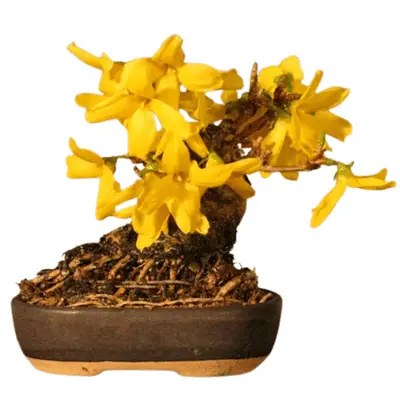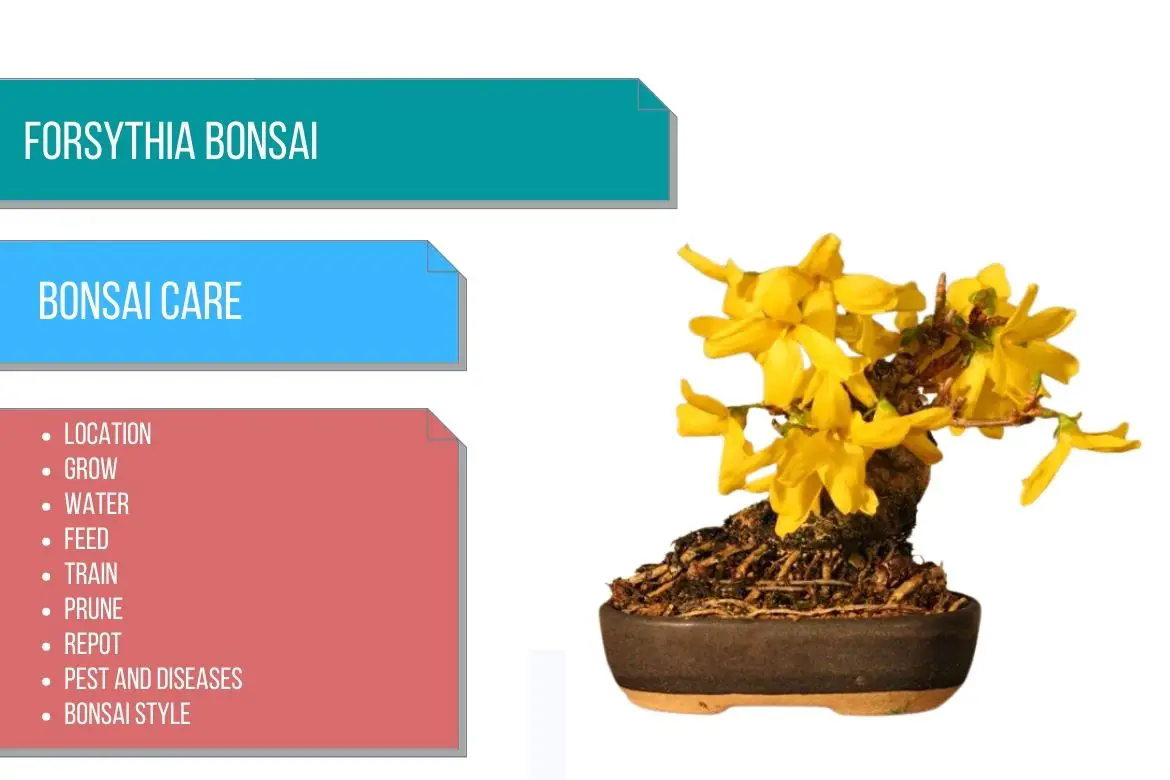
Forsythia
(Forsythia)
Country of Origin : Asia
Bonsai Styles : Informal upright, slanting, semi-cascade, cascade, twin-trunk, clump, multi-trunk
Zone : 5 – 9
Forsythia is a hardy deciduous tree. These easy-to-grow trees are among the most colorful of the early flowering shrubs.
In early and mid-spring, these shrubs produce dominant, bright yellow, bell-shaped flowers on bare stems (before the leaves arrive).
Forsythia is a fast-growing shrub with a stiff and compact growth habit. The leaves of this plant are lance-shaped, toothed, and dark green.
Most of the species of Forsythia are coarse-growing (except for dwarf varieties).
Can you bonsai a forsythia?
Yes, forsythia shrubs can be grown as a beautiful flowering bonsai tree. Furthermore, the bright yellow flowers of the plant are complemented even more by its tender young leaves. These plants are suitable for the informal, cascade and root-over-rock bonsai styles. It is also possible to make large trunk specimens from established garden plants. Select a specimen with an intriguing root system and trunk. Shorten the trunk to the desired size.
Some of the species of forsythia that can be used to make a bonsai are:
- Forsythia intermedia – Also known as border forsythia. Use this Forsythia species if you want clusters of golden-yellow flowers.
- Forsythia intermedia ‘Minigold’ – Compact dwarf form of F. intermedia but same flowers. Dwarf varieties are suitable for group plantings.
- Forsythia ovata ‘Tetragold’ – This is also a dwarf variety of Forsythia. It produces golden yellow flowers which appear earlier than most of the other Forsythia species.
- Forsythia suspensa – Also known as golden bell or weeping Forsythia.
The dwarf forsythia is well suited to casual group plantings because of its profusion of flowers. Arrange the cuttings in a container for propagation and as these cuttings produce sufficient roots, move the whole group together into a shallow bonsai pot.
The trunk of these trees also tends to rot as the tree matures. Hence, these trees are not long lived when grown as a bonsai. In cases where rot has progressed too far, you should start over with a young plant.
Read more about other bonsai trees species in : Types of bonsai tree
Best location to keep Forsythia bonsai tree
These are considered as outdoor bonsai trees. Keep Forsythia bonsai trees in full sun throughout the year. Keep it at a place which becomes shady in the afternoon.
As these trees are native to warm climates, they require protection during the winter months.
IMP: Refer to do bonsai trees need sunlight for more indoor and outdoor bonsai location ideas. Also, refer sunlight requirements for indoor plants for more indoor gardening ideas.
Propagation of Forsythia bonsai tree
Forsythia can be propagated by using hardwood cutting in the fall season.
Layering method is also suitable for propagating them.
Watering Forsythia bonsai tree
Throughout the growing season, Forsythia bonsai should be watered regularly.
The soil should not be allowed to dry out completely, especially during the fall season, which is the time when flower buds are starting to form for the coming year.
In the winter, the soil should be kept just moist.
Read watering bonsai tree for more details and also about bonsai water immersion technique.
Wiring Forsythia bonsai tree
Generally there is no need to wire Forsythia bonsai trees.
However, you can still wire the branches. Wire the new shoots emerging from new wood when they have become slightly woody.
Do not leave the wire on the tree for more than one year.
Read : Detailed guide on How to wire a bonsai. This extensive guide includes all the wiring techniques and Do’s and Dont’s. It will also show you other bonsai training techniques which can be achieved without using wires.
Pruning Forsythia bonsai tree
When to prune Forsythia bonsai tree?
How to prune Forsythia bonsai tree?
In order to encourage new flowering shoots to grow, it is recommended that the old shoots that carried the current season’s flowers be pruned immediately after flowering.
It is generally a good practice to prune back new shoots to two or three leaves shortly after the tree has flowered.
In order to keep the plant in shape and stimulate the production of secondary branches, prune any very long new shoots that appear on the plant.
As soon as two or three leaves have formed, pinch out the growing tips of these shoots. However, make sure you don’t pinch excessively after midsummer to prevent removing next year’s flower buds.
Several trees benefit from early spring pruning of old wood because it promotes compact new growth in the coming season. It is not advisable to use this early old-wood pruning technique for most of the early flowering trees such as forsythia. (Also, crab apple, hawthorn, winter jasmine, apricots, and cherries). Or else you will remove the flower buds formed on the previous season’s wood.
Read how to prune a bonsai to know about the right technique of pruning and more about defoliating a bonsai tree.
Repotting Forsythia bonsai tree
How to repot Forsythia tree?
Forsythia bonsai trees can be repotted every second year in early spring after flowering.
Use a standard free-draining bonsai soil mix.
You can also use sharp sand, loam, and peat moss (or garden compost) in the ratio of 1:1:1.
Please check out how to repot a bonsai to know everything about repotting and root pruning a bonsai.
Must Read: Bonsai Soil Recipes
Must read : Choosing the right bonsai container
Feeding Forsythia bonsai tree
After flowering, fertilize the bonsai with a general fertilizer. Late summer is also a good time to feed plants with a low-nitrogen fertilizer.
Read more about bonsai fertilizer and its application. This will also give you more details on how to feed flowering bonsai trees.
Diseases and pest of Forsythia bonsai tree
In this species, aphids are sometimes a problem, but they usually occur in such small numbers that they can be manually removed (hands or use of jet of water). Apply a systemic insecticide in case the infection becomes severe.
It is possible for some plants to be affected by the forsythia gall. Also, early in the spring, birds may eat flower buds.
Our comprehensive guide: How to identify and treat bonsai pests and diseases is a great resource for you to see all the organic and inorganic remedies you can use.

